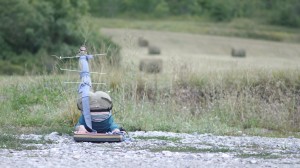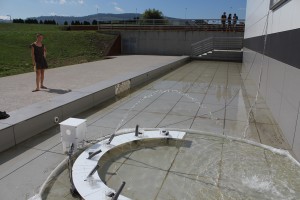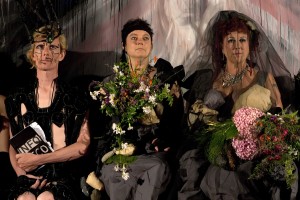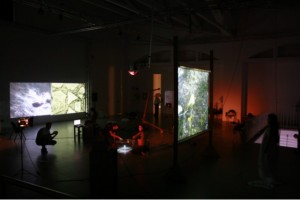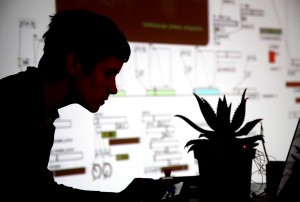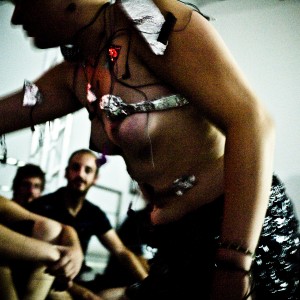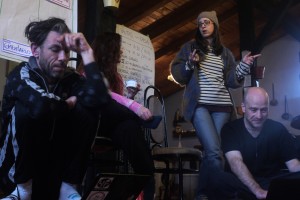Collective Emergencies
INDEX :
INTRO
SATELITES AND CRITICAL COMMUNICATIONS – HACKING THE PANOPTICON
ECOSEX – FEELING THE WORLD
TELEPRESENCE – HERE AND THERE, NOW
TRANSHACKERFEMINISM
OPEN CODE CULTURAL PRACTISES
///
INTRODUCTION
We are living in the age of biotechnology, announcing the cyborg. Uncritically rushing towards a prosthetic future, seperated between an immense class of slaves in constant poverty and a tiny group of wealthy semi artifical beings ready for anything to coldly maintain and extend their privileges. Technology becomes a plague on the planet, destroying huge areas of wilderness to extract the materiales necessary to extend itself, employed in wars that are more and more remote from the centres of control, systems of vigilance to control the slaves, keeping them locked into an endless loop of insatisfied desire, sickness and misery. Artists amuse the masters and distract the slaves, all discourses absorbed into a black hole of meaning. Critical currents are merely inconvenient, easily strangled economically and, if needs be, coercively. This bleak picture is not just an exercise of science fiction but neither is it all true. The sheer velocity and multiplicty of the changes in the planet create chaotic states where nobody is really in control anymore and unexpected cracks open up. Emergencies are, at the same time, moments of danger and the appearance of undirected forms.
“What we look for in art is a different way to live, a fresh chance at coexistence.” Brian Holmes [1]
From the imagination and the critical view we start to enunciate specific subjectivities. Orphans of a science fiction future that has trapped us in a shiny plastic world that sucks our life force into a black hole of abstract numbers. Present currents are connecting back to nature, re-apropriation & critical use of technology. Emergencies are, at the same time, moments of danger and the appearance of undirected forms. Networks cross and reconnect generating cultures of complexity. The cross between nature, human and technology inspires fractal developments at hyper speed. Our reality is too complex to grasp individually. Art and artists mutating, collectivising. Art as a practice, creativity, a dynamic social process. Investigation and construction of narratives, individual and collective, learning and exchange. Creation has always been both collective and individual, as Virginia Woolf points out in “A Room of One’s Own” :
“For masterpieces are not single and solitary births ; they are the outcome of many years of thinking in common, of thinking by the body of the people, so that the experience of the mass is behind the single voice” Virginia Woolf [2]
but it seems that, in the age of networks and unprecedented accesibility, this collective aspect is becoming more important and necessary. The political movements of 2011 – the Arab Spring, 15-M, the Occupy movement – have made this clear as never before. Creation springs from unexpected places and people, you can never tell what is going to come out of a collective process but what does come out is usually not what you could have imagined.
For almost all of our evolutionary history we have lived in small nomadic groups of 15-20 individuals, our technology was almost entirely internal, biologico. Some 10 000 years ago agriculture appeared and, some argue, our decline began. Whether you are a luddite or a posthumanist will determine your degree of optimism, but nobody can doubt that we are living in times of mutation, chaotic and rapid, everything speeding up.
The projects discussed in this text bring into focus a series of currents and practises that indicate how artistic practises emerge from collective changes of perception, intense spaces of learning and interchange. We see that the process of investigation is fundamental to creation, examine the role of the body and the affects, DIY practises and materials, science and nature, the alchemical formation of group. We find that hacking – both in terms of technology and in terms of the symbolic structures that govern our thinking – is central to our practises.
As Simona Levi writes in “Working notes for a Revolution”: “It is clear that the use of the Network of Networks is changing the history of humanity. Not only is it permitting capilary forms of contrainformation and auto-organisation; not only are the powers that be dumbfounded by the end of their one way communications, confronted by the real time end of the impunity of decisions to perpetrate their power and interests, but the people – through the network and as the network – is dialetically finishing with the atomisation of the ideas of change and the endogamy of the groups, establishing a new ethic based on the recognition of the merits and capabilities of each invididual, permiting their maturity and autonomy and normalising forms of organisation where control is descentralised, the enduser empowered and the distribution of resources, shared” [15]
–
SATELITES AND CRITICAL COMMUNICATIONS – HACKING THE PANOPTICON
One of the technologies that, while being invisible, has the most impact on our collective lives is that of satelites. The first, Sputnik, was launched on October 4 1957. A few years later the first humans saw the planet from space. This seeing of the whole was a preview of the planetary consciousness (or simulacrum of consciousness, depends how you see it) that is now being implemented.
In the Orbitando Satélites meeting we sought to investigate this consciousness – Outer and Orbital Space as a Commons – a space that is of all of us to use and access – both in technological and imaginative ways. The meeting took place in May 2011 in LABoral Art Centre. The group learnt to build antenas, listen to the satelites, use radio and tracking technology. We also explored the history and the imaginary of space and of satelites.
The meeting had emerged almost by itself. David Pello, a hacker and specialist in open software and hardware, was fascinated by the possibility of creating a sub-orbital vehicle for exploring the outer reaches of the atmosphere. His interest ran in parallel with the researches of Alejandro Duque and the Brazilian MSST team. The former is an artist and investigator fascinated by satelites and radio. MSST is the “without satellite movement” – the name is a play on the initials of the Movement Without Land, that swept through Brasil squatting lands for agricultural use and that later expanded into urban squats for families. They are a group that work in a poetic and ambiguous way, thoughtful hackers, questioning the very nature of technology :
“The day we will be able to build our first handmade satellite and send it to this sidereal space which is already full of corporative and governamental devices. Will our satellite be able to transform our networks in something more autonomous? Or do we have to re-think all technocracy to reach that by a totally different path? How?” MSST Manifesto [5]
Lord Epsylon, participant in the Lorea.org project, a network of autonomous social networks, alternative to facebook, was also present in the meeting. Coming from hacker culture he is especially interested in autonomous infrastructures. Satelite technology and balloons cd be used to create floating routers for adhoc networks permitting communication when internet is cut. It was him who called our attention to Hacker Space Program, presented for the first time the Caos Computer Club summer meeting in Berlin. In fact during 2011 amateur space programs became more present and the hacker community began to work seriously on the idea of autonomous satelites.
For Alejo Duque there is absolutely no need to create new satelites, he believes in listening, in hacking the existing satelites, in reusing them, he’s fascinated by the constellations of manmade space objects, their secrets, their imaginary of all that. Out of his work with antennae, “fishing for satellites” as he calls it, has emerged a “yoga” de antenas, cuando la antena forma parte o continuación del cuerpo. The antenna is like a magical wand for listening to disembodied voices – its form so precise, it has to be that shape and size in order to function, to be pointed in the right direction at the right time. Like the precise forms of the voodoo diagrams for the invocation of the loa (gods) or the symbols of ancient spell books.
Joanna Griffin is an artist specialised in satelites, her project satelite stories was supported by Art Catalyst in London and she has spent years in India researching the Indian space program and developing workshops. She guided us through exercises to explore the imaginary of the satelites, devenir satelite, we imagined ourselves as them, imagined them hurtling through space. I especially liked one satelite that was launched in the 70s and whose battery has long since died. It wakes only when receiving direct sun on its solar panels and starts to transmit randomly on one of its 4 modes. I like to think of this specialised creature spinning round the earth, tiny in the immensity. Its not a satelite like you have seen on the news, enormous shiny creatures, its just a 1 cm cube !
“[T]here are other things that need doing, and one of these is the development of an imaginary of technology, an understanding of its poetics and a testing manifestation of those poetics in ways that allow us to think and sense through what that technology is.” — Matt Fuller [6]
These transmissions, this sound space, reminded us of the cold war, landscapes of static from which emerge, like ghosts, fragments of morse code, voices, harsh bursts of digital noise carrying some occult message. Reni Hoefmuller is an artist from Austria who runs a small arts centre in the town of Graz, she is also a sound artist and was active in pirate radio. Her organisation mur.at is launching a satellite and she too is fascinated by the sound and by the radio transmission. Extraordinary to think of those radio waves travelling to and fro, from the earth to the orbit. In the stream that we created to present the results of the meeting she and Xiu explained to the public how to make antenas. Bruno Vianna made an appearance there also (the recording of this sequence ended up being shown in the exhibition), talking about his investigation into salt water antennae which materialised in his project “Ionic Satellite Fountain”. His mixture of mysticism, play, technology and water is well documented in his blog [7] of the project and was one of the necesities that drove the project’s software development.
All this coincided with the 50th anniversary of Yuri Gagarin’s first flight into space, another pregnant coincidence. We transmitted the presentation of our meeting in streaming which was received in Moscow where Daria Parkhemenko was celebrating an exhibition in her lab.
The radio waves, natural frequencies, piggy backing, the russians who hide signals in the pulse of the earth, the VLF, very low frequencies, were investigated by the mp19 crew – they also played at the inauguration of the exhibition with their project SAGAAN that was later invited to play at Piksel in Noruega with Lord Epsylon tracking radio signals. The video and performance created by Lorena Lozano, Nuria Rodríguez and Cristina Ferrández mixed texts and images of space and satelites investigating how our imaginary has been created and formed by our experience of space as an audiovisual phenomenon, the launchpad for our imaginations. The texts used can be read in the book of Orbitando Satélites as well as a collection of other documents relevant to the project. [14]
The process of software development that was launched from the meeting continued during some months. GPredict is a program for Linux that enables the user to predict when a particular satelite will be passing overhead. We needed to enable it to send the details of the satellite by OSC (Open Sound Control), a protocol for sending data, in order to be able to pilot the OpenRotor and to activate the fountains when a satellite passed over. Husk, another participant in the meeting, a musician and Pure Data hacker, used this data in Pure Data to generate a realtime soundscape that changes depending on the positions of the satelites. This piece was shown in the Orbitando exhibition and he was subsequently invited to present it at the CulturaDigital.Br festival in Rio de Janeiro. He writes :
“All the software used is free and open. All is experimental software that allows one to play with concepts and creative uses that find no place in the productivist logic typical of commercial software. A process which is born in the network and which, in the free circulation of knowledge, ideas and code finds its form. A collective intelligence that brings dreams to life and form”. [8]
It’s a good example of how artistic research drives scientific development. “The lab is the network”. Artistic needs generate technical solutions. Let’s move from military to artistic necesities! The saying that war is the mother of invention is undoubtly true but creation is a far more compelling and welcome mother. The participants all spoke of a great sense of delight and pleasure to take part in this meeting. The flowing of energies in such a diverse group creates a new consciousness, a becoming that is fundamental in effecting changes in consciousness.
–
ECOSEX – FEELING THE WORLD
“… the capacity to be affected has already in germ a capacity to experience joyful encounters as an activity of becoming that opens itself up to a futurity entering the present to change a state of affairs.” Luciana Parisi [9]
This joyful encounter is exemplified in the work of Annie Sprinkle and Beth Stephens. As part of their love laboratory project they have been getting married for a period of seven years. The wedding in Gijón was to be the last in the series. They are a couple who live in San Francisco, two women with serious credentials. Beth Stephens is an art teacher in the UCLA, an activist and a legendary lover. Annie Sprinkle, who proudly presents herself as the only pornstar with a degree in Sexology, is a performance artist and co-inventor, with Beth Stephens, of the Ecosexual movement. Basically the idea is that we should change our perception of the earth from mother to lover. As they say in their manifesto :
“WE ARE THE ECOSEXUALS. The Earth is our lover. We are madly, passionately, and fiercely in love, and we are grateful for this relationship each and every day. In order to create a more mutual and sustainable relationship with the Earth, we collaborate with nature. We treat the Earth with kindness, respect and affection.” Manifiesto Ecosexual v 1.0 [10]
Announced as an ecofemenism workshop the word quickly got round and as if by magic a very special group formed. Some, like Graham Tornado Bell or Laura Milano, followed from Barcelona where they had participated in the Wedding to the Rocks in the CCCB. I have found that this is a characteristic of activities whose time and space is right, the groups form themselves, emerging seemingly from nothing. In the public announcement we mentioned nothing about sex or love – Cascos had just been elected and the institution was very nervous. As the date of the event got closer the truth of it emerged to the direction and the planned press conference to present the activity was cancelled. Fear began to spread through the institution but it was too late to stop the activity. There was talk about stopping the performance but support came from unexpected quarters and we only suffered a media blackout.
The project that englobed the weddings, the Love Art Laboratory, “grew out of our response to the violence of war, the anti-gay marriage movement, and our prevailing culture of greed” and is “committed to doing projects that explore, generate, and celebrate love …” – starting in 2005 with a project around the breast cancer of Annie Sprinkle where Beth shaved her head and accompanied Annie through the phases of the chimiotherapy. Following that, each year, they celebrated weddings as an ongoing art project, involving communities in different countries and cities. The process is very well documented on their website http://loveartlab.org . Its a systematic process of marrying all the elements of nature and the planet, the moon, the sky.
In Gijón, obviously, they decided to get married to Coal. The driving force of the industrial revolution, the history of coal is the history of the emergence of capitalism and Asturias was one of the main mining areas of Spain. Beth Stephens comes from a coalmining family and is now an activist trying to stop the open air mining in West Virginia in the United States – every week explosives with power of the equivalent of Hiroshima are used to remove mountain tops to mine the coal resulting in incalculable environmental damage. The abuse of the earth that the mining has and continues to entail.
The love art laboratory seeks to change consciousness, making us aware of the connection between body and world (as Phil Shepherd says “if you are divided from your body you are divided from the world”), between ecology and love, the power of affect :
“…joyful passions – i.e., passions that increase a collective power of action – are the real immanent engineers of new modifications requiring the collective agreement of bodies-minds and their capacities to push the agreement on a newly constituted level.” Luciana Parisi [9]
The group that had constituted itself prepared performances for the wedding, to be celebrated, appropriately, in the Semana Negra of Gijón. In some sense the wedding had already occurred, being together these days, sharing space, food, ecosexual activities. Maribel López y Jorge Nava have made a video where they interview many of the participants about their understanding of ecosex [10b]. Joy is continually present, love of nature, of the planet.
Suddenly a new territory had emerged – deeply anchored in the local but completely unexplored. Another fold in the fractal landscape of our art. At the end of the wedding, all of us outside singing, a group of middle aged women joined us in “Sta Barbara” the song to the patron saint of the miners. Because it wasnt just ourselves we were talking about, loving, marrying, but all the people involved in the coal, the planet, the economies, the workers movement – Cucu Suárez’s marvellous wedding cake was a pile of tires, 5 high, each tire a little smaller than the one beneath. It was a clear quoting of the practises in the endemic miners strikes of the 80s, where they would burn tires cutting off roads or protesting in the centre of gijón.
–
TELEPRESENCIA
There can be no doubt that Internet – and the free software on which it is built – has been a fundamental change in our culture in the last decades, opening cracks in the difusion of knowledge and the connection between people, collapsing space and time. Infecting culture with the memes of free software – changing our concept of the art object. Multiple presences without distance, magical capacities of action at distance, sharing of experience and knowledge, centres are anywhere and everywhere, enormous interrelated affective beings. This networked being gives us confidence and permits the creation of community beyond the physical space. Physical spaces take on other profiles, necesities – the meeting of bodies, spaces of co-creation or relation, eating and walking together.
When we were all connected during hours in real time to the events in Tahrir in January 2011 we experienced a new level of the capacity for remote presence that we have been developing through Internet. Anonymous coordinating massive attacks on webservers, hacker wars, invisible masses. This sense of connected groups, carrying out activities or simply being together is contributing to an increasing sense of global unity. On a practical level with rising prices of combustibles travel will start becoming an unaffordable luxury restrained to the global elite and we need to start developing forms of collective meeting, beyond the one on one experience of telepresence to which we are accustomed via skype or chat. Something like the Internet Relay Chat (IRC) rooms expanded to include audio, video and sensor data. The planetary laboratory is being born, citizen laboratory, developing autonomous networks, decentralised and open code. More and more international, more and more local, the terms start to mix. Planetary consciousness.
We need to work on many levels, maybe the emotional is the most important of all. It is, after all, the heart that is truly the organ of communication, the practise of empathy that we learnt from Annie Sprinkle and Beth Stephens, love understood in a new way as an opening to the world and all its levels or strata, the new planetary vunerability. There is no doubt that successful collaboration and communication online starts from the affective, we have seen it again and again. The daily practise of telepresence through its multiple forms of action at distance brings with it a training of the imagination – the capacity of distant presence is in the body already, in its infinite circuits and cells and its capacity of imagination. The capacity of telepresence depends on the emotional and imaginative capacity of the individual.
These theses were tested in the Telepresence meeting that was organised in December 2011 simultaneously in Hangar, Barcelona, and Laboral, Gijón, with temporary connections to Poitiers and Montréal. Using the Scenic software developed by the SAT in Montréal and a high speed fibreoptic connection we were able to carry out, for a week, an experiment in working together at distance. Not only did audio and video data transit through the network but also multiple sensor data – humidity, light, pressure, on/off. INTACT created a special performance [22] and The distributed group was exceptional – Marcel·li Antúnez, Minipimer.tv, Intact, Alg-a, Jorge Luis Marzo, el pueblo de china, Paula Pin and many more who had responded to the open call – but there were moments when communication failed. It was very interesting to note, once again, the importance of affective bonds that create effective communication at distance. The large and heterogenous group spread between two distant points meant that often the attention was put more in the local than the distant. Often we failed to create a real sense of being together. It was not so much a technical question as a human one. Much more work is required to develop the emotional, organisational and technical skills for collective telepresence to become truly operative – I believe that this is an area that institutions, with their access to high speed networks and spaces equipped for large numbers of people to gather, should be developing and researching. It will be absolutely critical in the future and a fundamental function of a cultural centre.
Some weeks later La Quimera Rosa arrived in the lab to work on their Sexoskeleton [14], a wearable dispositive that makes visible the vital signs of the body – heart, galvanic skin response, humidity. This data can be transmitted by internet to anywhere in the world, like the sensors in the ecoLAB, another project that began in 2011 in LABoral and is now continuing, supervised by Lorena Lozano and Ruben Suarez. This possibility to FEEL biologically at distance opens new and astounding possibilities for the imagination and the connection. The project that won the Next Things convocatory, a joint project between the Telefonica research labs and LABoral, Mapocci by Laura Malinverni and Lilia Villafuerte, also goes in this sense and in the Bogotrax festival in 2012 Victoria Sinclair and the festival team organised telepresence sessions in the Carcel Distrito prison in Bogotá, Colombia. Its a powerful metaphor, opening cracks in the walls of the prison.
The Mapocci proposal seeks to provide new ways of remote communication, capable of generating empathic networks between children in different places, facilitating cultural exchange and offering a tool for sharing and understanding the emotions of others. Mapocci is a device based on a wireless connection system which through a structure of sensors, sound actuators and exchangers allows for the remote communication of emotional states. The mechanism is a stand-alone device and does not require a computer in order to operate but a minimum of two devices connected to each other. Each one belongs to a child and the physical interactions with a model will be reflected in the behaviour of the other one and vice versa. In this way, the non-tangible interconnected links that exist between all human beings, and the active role played by each one in determining the sensations and emotions of the other one, are highlighted.
Paula Pin, in her recent works, connects these sensors to plants, humans and the immediate environment at the same time, generating soundscapes with a patch in Pure Data that process the inputs received into sound. The manner which she mixes realms usually understood as seperate, delving into the bacterial and cellular landscapes of our sexualities and our being in the world. In herself she unites the technological and queer narrativas with nature and biology in an ever spreading horizontal mesh of intuition and home made electronics.
–
TRANSHACKERFEMINISM
Pin and a range of other artists can be considered as transhackerfeministas. The term was coined for the meeting between the transfeminist, ecological, performative current that we had explored in the Boda Negra and the technological, hacker current of Orbitando that took place in the Summerlab 2011. There have been several writings about this event and abundant documentation is available online [12] so here I would like to simply mention a few of the themes that emerged there. The first, and perhaps most revolutionary, was the aforementioned meeting of currents. The transfeminist block with the techno-hacker block, especially in the area of hardware. People making their own instruments and performing together. The hackers drifting into the Install Party, a game that, using the metaphor of the operating system (OS) for gender constructions, proposed to install concepts like postporno, s&m, or desinstall, for example, machismo. Individuals wore a logo on their sleeve indicating their speciality and participants would ask them to carry out the installation or desinstallation. At the same time another install party, Linux Ubuntu in Asturian, was going on alongside. The experience of the summerlab was life changing, universes that had not realised how close they were, met and became aware and began to create together. The divide of female/body vs. male/machine had been crossed, has been crossed and becomes yearly less established. Transhackerfeminism.
Of course in a context such as this it was not surprising to meet up with Shu Lea Cheang ! Veteran artist crossing post-pornography con sci-fi queer, tech and ecological narratives, she was developing (along with Martin Hugg & Maca Moreno) her Virus game : Enter the BioNet [UKI game level 2] combining technology, science fiction and biology . Following on from her UKI project developed in Hangar in 2009 where the cream of the queer/postporno scene in Barcelona constructed a massive collective performance. The game builds on the world created for UKI, where the GENOM corporation has taken over humanity’s red blood cells in order to create their own bionet. Using wireless galvanic sensors which measure the level of excitement of the participants, the game consists in working collectively to defeat the Corporation and eliminate the infection.
Overall the summerlab became an immense learning experience, self-guided, each responsible for their desires, for what they could offer and take. “A space for experimentation and collective learning” as Margherita wrote. The importance of it’s openess, that there was no imposed line or finality. This serves to underline, in an even stronger way, the basic reality that groups do not need leaders, investigation does not need control. On the contrary, it is precisely in the unforeseen crossing of skills, desires and talents where the joy of creation and investigation can emerge. Joy again ! And food ! The kitchen that we set up, overcoming the opposition of the institution, was fundamental. A meeting must have cooking ! Institutions try to remove the body from their spaces because it is the true locus of change.
Ah those inconvenient bodies ! Our deepest joy and revelation becomes danger, especially when the bodies are gendered as female and they are unruly and present. Hysteria ! Fear ! Although telepresence and similar technologies are important it is finally the body that is the real politics, fine to read and think or watch television or internet but it is our bodies in space that finally create the new topographies, open up the cracks to the flows. PRESENCE. Sound of your body, microphone in the coño.
The frontiers between body, art, nature and society become difuse and require a new theory of emotions. Identity trembles as we reach deeper, human, plant, planet lose their outlines. At the same time, the frontiers of race, class and the State create ever higher and more densely vigilated walls. Our territories mutating at great velocity, efemeral and fragile connections, strong as spider webs. New stories and replies emerging to narrate our experience. New contexts to give birth and nurture the strange new creatures that emerge. Generating aesthetics contaminated by ethics, the nature of beauty is no longer the same. Networks which replace centres who become nodes, mixed networks between country and city, flows of desire and creations opening new landscapes, choreographies and social structures.
–
OPEN CODE CULTURAL PRACTISES & NEW MODELS FOR ART
“We can observe two tendencies in the management of local culture : that which takes as it’s reference open code and proposes structures of cooperation, coproduction, prototypes .. and those that are generated from closed code, based on the distribution of spectacles in any of their formats (exhibitions, museums, concerts ..)” Ramon Alba [4]
This new ethic is undoubtly influenced by the profound effect that the free software has had on culture, giving birth to what we call now Cultura Libre or Free Culture. Forms of organisation and sharing, even of licensing (see Creative Commons etc.) inspired by free software. As we saw in the model of the install party or the concept itself of the commons that is more and more present in our culture. It was with the goal to collect a series of notes, create a cartography of this way of working with culture that Susana Serrano invited [16] a dozen writers, cultural activists and creators to create a Decalogue of Open Code Cultural Practises using the Booksprint methodology. The meeting took place in Euskadi, close to Donostia, at the end of January 2012 and was organised by the Tabakalera Cultural Centre.
The booksprint is a methodology that Tomas Krag named in 2006 based on the code sprint. Like so many things in the world of culture and creation, it starts from the practises of free software. Tomas needed to write a book about wireless communication infrastructures and how to build them – a manual for developing countries that would enable the citizens to start building and experimenting without having to import experts [17]. The meeting with Adam Hyde in Zagreb in 2007 evolved the methodology – Adam adapted it for writing FLOSS manuals (documentation for free software) and added an extra twist – the book should be completely finished in the time of the sprint. To this end he and his team also developed the Booki software – an online tool for organising and formating the text in book form with its chapters and sections. Since then more than 40 manuals have been written using the methodology.
Before starting the sprint Susana and the other facilitators had asked the expanded network of open culture operators to send in keywords and concepts that they considered important for the book. The response was excellent, more than expected, and these words became the starting point for writing the book. We put them all together and, using techniques developed by Amasté (a group from Bilbao with long experience in organising collective events and workshops), we began to group the concepts into clouds which then began to form the basis for the chapters which were then divided up, each chapter being the responsability of a participant. This process took about 2 days and, although several participants found it a gruelling experience, for me it was another proof of the power of the capacity to think and work together in a horizontal way. We then had 3 days to write! It was so interesting to see, starting from a collection of keywords and an almost random collection of individuals with their desires and fears, a common work being generated, negotiated on the basis of consensus. It was, as is usual in operations of this horizontal nature, a transformative experience.
The book (in spanish) can be downloaded for free (16) and is a good overview of the type of attitudes and orientations that are driving the culture that we are making today. A collective culture based on the idea of the Commons. This concept underlies all the thinking that drive our investigations – a third way, neither private nor institutional, that considers culture as a collective resource to which we contribute and from which we draw.
This of course has important implications for art centres – the exhibition model is not sufficient in itself, art centres need to be centres of investigation, participation and crossing of worlds. Money needs to be invested in artists, in horizontal educative initiatives, in community, in real creation and not just the importation of ready made exhibitions configured by the taste of one or few directives. An art centre can have a real and profound impact on the the culture of a region if it is open and capable of being traversed by the currents of creation. It is a question of priorities more than funding (although also that, as i write Espai Zero in Olot has suddenly been closed, a 10 year old project that had become fundamental to the Spanish art infrastructure), a question of redressing the imbalances inherited from a pyramidal social structure. The art world is like the world of politics, in miniature, the same structures, the same injustices.
The projects that we have explored in this text were all realised in LABoral Centro de Arte during 2011. They met with increasing hostility from the direction of the centre and were welcomed by the local and wider community of artists. One of the accusations that has been levelled at these projects is that they are just for the “happy few” – “nobody can understand this” – in the context of an institution and/or the use of public money, what are the criteria for assessing these practices ? Should special care be taken in order to communicate them to a “general” audience ? We can research noise, but how noisy are we allowed to be ? Interferences in the machine. Complexity. Part of the answer is without doubt in documentation and communication but maybe we also have to accept that finished work and the process to get there are different things , experimentation, collectivity from which a work may emerge – irrigating the outside instead of absorbing all inputs into the black hole of empty spaces and administrative structures. This is a clear challenge to the cultural structures, especially the publicly funded, that they should really start to take seriously their function as collective resources. At the same time numerous spaces are emerging, both in cities and in the country, that carry out this function themselves – notably the Hacker Spaces [xx] or projects like Re-Colectivo in Asturias, explicitly connecting social, rural and artistic concerns.
We are really living a collective emergency – in both senses of the term. A profoundly dangerous moment for the planet, and at the same time, the practises we have explored in this text point to an emergency that could profoundly change our world. Art and authority are, and can only be, opposed. The commons means the privileged lose their privileges, breaking out of the ivory tower of the 0,1% that dictates the norms of the art industry and all else in the world. We find in art and in collective practises a space for generating something that looks more like the world in which we would like to live.
———–
[1] http://brianholmes.wordpress.com/2008/11/16/the-affectivist-manifesto/
[2] Virginia Woolf, A Room of One’s Own, 1928
[3] Budget of plataforma cero 2011 http://bit.ly/y7A7Tr
[4] http://www.edicionessimbioticas.info/Notas-para-una-etica-hacker-en-la
[5] MSST manifesto http://devolts.org/msst
[6] Matt Fuller http://www.spc.org/fuller/texts/towards-an-ecology-of-media-ecology/
[7] http://brunovianna.net/isf/?paged=2
[8] http://www.booki.cc/orbitando-satelites/gpredict-meets-din-meets-puredata/ – http://wiki.plataformacero.cc/index.php/Manuales_Orbitando
[9] Luciana Parisi, http://osdir.com/ml/culture.internet.rekombinant/2004-11/msg00009.html
[10] http://ecosexology.org /
[10b] Boda Negra http://www.youtube.com/watch?v=giP-kA3ia68 – Ecosex documentary http://www.youtube.com/watch?v=RQ1HW-vxS1Q
[12] http://summerlab.plataformacero.cc/wiki/index.php/DOCUMENTACI%C3%93N – http://susanaserrano.cc/2011/09/02/reboot-al-sistema-del-arte/
[13] http://summerlab.plataformacero.cc/wiki/index.php/Documento_Arco_Atl%C3%A1ntico
[14] Orbitando book http://bogotadeclaration.files.wordpress.com/2011/08/os_manual_lowres.pdf
[15] Simona Levi , 2011 http://www.desrealitat.org/2011/07/notas-de-trabajo-para-una-revolucion.html
[16] “Decálogo de prácticas culturales de código abierto”. Segura, 27 de enero al 1 de febrero, 2012 http://10penkult.cc
[17] The book that was written can be downloaded from http://wndw.net
[22] http://vimeo.com/37058260
Pedro Soler
March 2012
